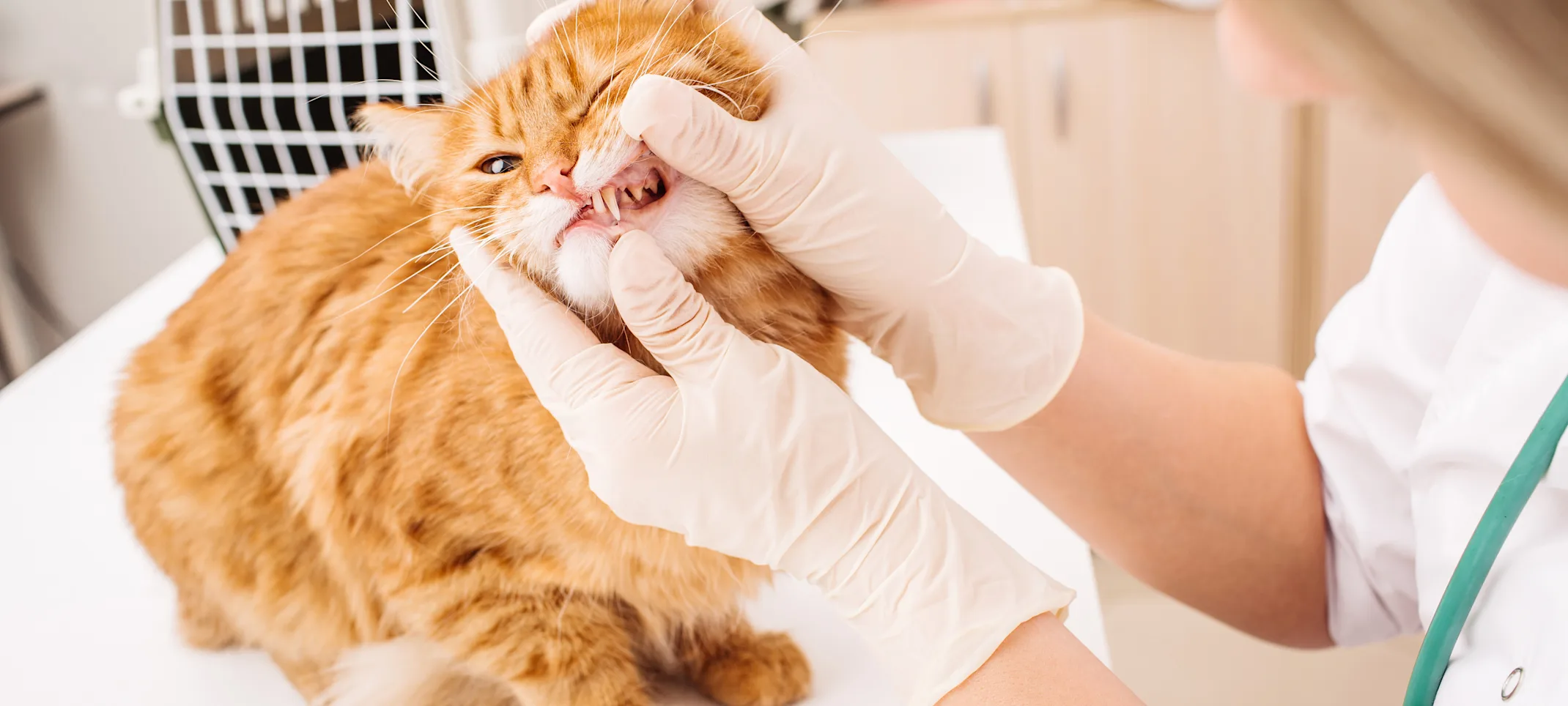Clark Animal Care Center
Dental Health Care

Oral Disease in Dogs and Cats
Oral disease is the most frequently diagnosed problem for pets. An astounding 80% of dogs and 70% of cats show signs of oral disease by the age of three. The most common dental problem among pets is periodontal disease, a painful condition that animals often suffer in silence.
Animals can suffer the same kinds of dental problems as humans, including infection, pain, and fractured teeth. Fortunately, pet owners can help prevent dental disease in their pets by providing dental care. To prevent dental problems, we recommend many various dental products, such as toothbrushes, tooth sealants, special treats, etc. We recommend that pet owners look for warning signs such as bad breath (halitosis), tartar buildup on teeth, change in eating habits, fractured or abscessed teeth, and swollen, receding, or bleeding gums. Call us at (585) 377-1160 if any of these symptoms are present. These warning signs can be a sign of serious dental health problems.
Proper dental care is critical to a pet’s overall good health. It is suspected that if oral infections such as periodontal disease are left untreated, they can travel through the bloodstream and damage internal organs.
Oral disease begins with a buildup of bacteria in the pet’s mouth. Bacteria, combined with saliva and food debris between the tooth and gum, can cause plaque formations to accumulate on the teeth. As bacteria grow in the plaque and as calcium salts are deposited, plaque turns to mineralized tartar.
If tartar is not removed from the teeth, pockets of pus may appear along the gum line and further separate the teeth from the gum. This allows for food and bacteria to accumulate. Without proper treatment, this plaque and tartar buildup may cause irreversible periodontal disease, which affects the tissue and bone supporting the teeth.
Periodontitis is irreversible and may lead to other health problems. Unlike the inflamed gums of gingivitis, which can be treated and reversed with thorough plaque removal and continued plaque control, periodontitis can only be contained to prevent progression. The disease causes red, swollen and tender gums, receding gums, bleeding, pain, and bad breath. Untreated, periodontitis can lead to tooth loss.
Left untreated, oral disease can systematically affect your pet’s heart, liver, and kidneys in addition to making daily life miserable from the oral pain they suffer. Additionally, pets with advanced oral disease often suffer from lethargy due to chronic pain, difficulty eating, and constant exposure to infection.
5 Signs of “Dental Pain” in Pets
Your pets can’t tell you when they’re suffering from a toothache or other types of pain. If you notice any of these signs, contact us at 585-377-1160 to schedule an exam.
1. No signs at all.
Dogs, cats and other companion animals, such as rabbits, rarely show signs of dental pain. This is a survival mechanism, an instinctual behavior that our domesticated animals have in common with their wild ancestors.
2. Bad breath.
The odor is a byproduct of the bacterial metabolic process. In pets with periodontal disease, there is more bacteria in the mouth, and so the odor increases. “Doggy breath” or “tuna breath” is not normal and needs to be evaluated.
3. Altered behavior.
Chewing on one side of the mouth, dropping food, running away from the food dish, crying when yawning, hiding, not grooming themselves and acting “grumpy” are all signs of dental pain. You know your pet better than anyone, so look for abnormal behaviors.
4. Bleeding.
Bleeding from the mouth is usually due to periodontal disease, but it could also be evidence of fractured teeth, lacerations or ulcers on the tongue or gum tissue or the presence of an oral mass. Look for thick, ropey saliva, spots of blood found on toys or beds or drops of blood in the water or food dish. If the periodontal disease is severe enough, you may notice bleeding from the nose or bloody discharge when your pet sneezes.
5. Return to normal.
Once our veterinary team addresses your pet’s oral issues your pooch may show he’s feeling better by acting like a puppy again or your kitty might seek extra attention.
Don’t let your pets suffer in silence! They don’t just have a toothache, they have a whole mouth full of toothaches. Daily dental hygiene is free. All you need is a toothbrush and a couple of minutes to help prevent periodontal disease.
Bad breath (halitosis) in pets
Does your pet’s mouth smell not so sweet? A bad odor can be a sign of serious problems for your pet, such as periodontal disease or oral or systemic infection. So discuss your pet’s problem with your your veterinarian.
Common mouth myths: true or false?
Pets are supposed to have bad breath. False. An odor is not normal. Just like in people, bad breath in pets is often a sign of dental disease and requires treatment to safeguard your pet’s health.
Pets don’t need regular oral hygiene. False. Even with regular dental cleanings at your veterinary practice, your pet still needs regular tooth brushing to keep his breath sweet and his pearly whites sparkling.
Pets’ mouths clean themselves. False. While there are some natural enzyme systems at work in your pet’s mouth, it will not keep your pet’s mouth clean. Debris builds up on your pet’s teeth and requires brushing or rubbing to keep the mouth fresh.
Cats don’t need dental care. False. Cats and small-breed dogs often require more dental care then larger-breed dogs.
Cats have stinky breath because they eat smelly foods. False. An odor in your cat’s mouth is a sign of health problem, and you should discuss your pet’s problem with your veterinarian.
Prevention: The best medicine You can prevent bad breath and dental disease with regular oral care. Your veterinarian recommends daily tooth brushing. This is the best way to keep your pet’s mouth healthy. You may also use daily oral hygiene rinses, dental diets, water additives, and safe chew toys to keep your pet’s mouth clean.
Remember, the more home care that you offer to prevent dental disease, the less care your veterinarian will need to provide to treat problems in the future.
Signs your pet is suffering from dental disease
Bad breath
Red gums (healthy gums are a pink, shrimp-like color)
Pus oozing from gums
Facial swelling
Yellow or brownish buildup on the teeth
Pain
Another clue that your pet may be in pain is if it goes to the food bowl and backs away as if scared or drops food from its mouth.
Treatment: What your veterinarian will do Your veterinarian will conduct a thorough head-to-toe exam as well as a comprehensive oral exam. If the doctor identifies signs of dental disease, he or she may recommend preanesthetic testing. This may include blood work and an electrocardiogram to see whether your pet is a candidate for anesthesia. It is necessary for your pet to be anesthetized for your veterinarian to fully diagnose the source of the problem and take steps to correct it.
Remember, untreated dental problems in pets have been linked to serious medical problems, including heart, liver, and kidney disease. So if you notice bad breath or other signs of dental disease, schedule an appointment with your veterinarian.
The Veterinary Oral Health Council is helping to control the most common disease in dogs and cats, Periodontal Disease (Gum Disease). The VOHC has a list of products that have been awarded the VOHC seal, based on pre-set standards. To learn more about these products, click here.
